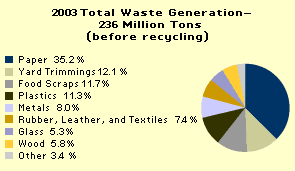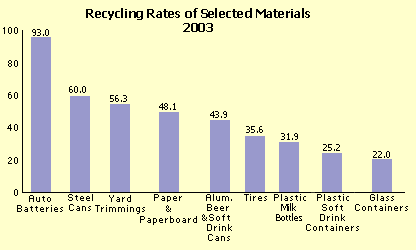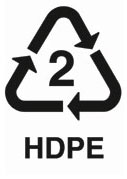 I recycle. I’m not a lunatic about it, but I do think it is a good idea to make the best of our trash problem on this planet. Don’t roll your eyes, I don’t hug trees; I just recycle when I can. It doesn’t take a whole lot of energy, just make two piles of trash instead of one. If I toss an empty water bottle into the wrong receptacle (we have three city-provided giant receptacles, one each for trash, green waste and recyclables), you won’t find me, legs dangling wildly in the air, trying to fish it out. What happens in the trashcan stays in the trashcan; Elsa, Matthew and I know about all of the other fun treats that go in there, and I’d rather clean the toilet with my toothbrush than spend any more of my life with the trashcan lid open any longer than absolutely necessary. Like I said, I’m into recycling, but I’m not crazy.
I recycle. I’m not a lunatic about it, but I do think it is a good idea to make the best of our trash problem on this planet. Don’t roll your eyes, I don’t hug trees; I just recycle when I can. It doesn’t take a whole lot of energy, just make two piles of trash instead of one. If I toss an empty water bottle into the wrong receptacle (we have three city-provided giant receptacles, one each for trash, green waste and recyclables), you won’t find me, legs dangling wildly in the air, trying to fish it out. What happens in the trashcan stays in the trashcan; Elsa, Matthew and I know about all of the other fun treats that go in there, and I’d rather clean the toilet with my toothbrush than spend any more of my life with the trashcan lid open any longer than absolutely necessary. Like I said, I’m into recycling, but I’m not crazy.Lately, I’ve been struggling with a moral dilemma about recycling, okay, it’s a monetary dilemma, you caught me. What’s the point? Who benefits? Not me. Get this: I have to pay the city for the privilege of recycling, $4.90 worth each month. Plus, they get all of the recyclables to sell to brokers at what I’m sure amounts to a profit for them, otherwise they probably wouldn’t do it. What do I get out of it? A big fat bucket of nothing. I do the work, I pay the fees even, and I don’t get a share in the profits. But the real insult is that I don’t see the results of my efforts; I don’t get any satisfaction when I buy things that I would be certain are made out of recycled materials because I can’t seem to find any products that actually use recycled materials in their packaging. I took a little tour of the cupboard and refrigerator this morning in search of packaging made out of recycled materials; after all, if I recycle and millions of other people sift through their rubbish with the same “think globally, act locally” mentality, then the world should be flush with packaging stuffed to the cardboard core with recycled materials, right?
In the refrigerator I found dozens of products we use on a regular basis, big name stuff, Alta Dena milk, Minute Maid orange juice, Mountain High vanilla yogurt, Kraft Cool-Whip, Brummel & Brown butter, Jell-O, Pepsi, Coke, Best Foods, Imperial butter, Heinz ketchup, French’s mustard (et tu, Brute?) and Hershey’s chocolate syrup. None of these use recycled materials in the construction of their products, unless they are so modest as to not want to brag about it. It’s the same tragedy in the pantry as well, as everything from Aunt Jemima pancake batter to Ritz crackers makes no mention of their use of recycled materials in their boxes and bags.
It’s not like we shop for products that are unheard of, like Bob’s milk or Bag O’ Crackers; we offer our patronage to big name companies…and for what? They continue to cut down trees and dam up the landfills with plastics. Oh the horror, the horror.
But wait, this just in: Kara returns from the store with a tubular can of Pringles. Sour Cream & Onion variety, zero grams of trans fat… they’re giving away an honest-to-God Coleman grill on their website http://www.pringles.com/. Glory day to be popping Pringles and burning up a few hot dogs on a Coleman. Pringles: The “can that pops when you pop it” (or whatever asinine catch phrase they hope we receive into the lexicon of pop culture). Anyway, the nine-inch-tall, three-inch-diameter can of salty goodness is made from recycled material… as they proudly proclaim their involvement in saving the world’s resources, but therein lies the confusion.
On the can—with that smug round-headed barbershop quartet-looking mascot and his cocky knowing wink that says, “Oh you’ll eat my Pringles and you’ll like them because I said so, pal”—it says “Canister contains at least 50% recycled material; 15% post-consumer content.” That sounds great, half of this cardboard can used to be something else, and for a moment their I have a transference of clairvoyance and I can see into the past lives of the cardboard. Someone used it to store rotten fruit inside a dumpster, and then it was recycled and in it’s next life it was a flattened box catching drips of oil underneath a dump truck…but wait, what is this I see? After that, it was recycled and it became a napkin at a Taco Bell, and someone took too many… and then they ran out of toilet paper and reached for the only thing in the area (they ate Taco Bell, remember?). It got strained out at the water treatment plant and then recycled, and here it is, holding my 5.75 ounces of “potato crisps.” How lovely a picture.
What? What’s this? Post-consumer content? What an odd thing to say. It sounds like something I’d find in a diaper, as in, Matthew has a diaper full of post-consumer content. It sounds like recycling. “Post” means after; “consumer” why, that’s me! And “content” is something that’s in something else. So, after I use something, it goes into making this can, a whole 15% of it’s volume.
 Well, I figure the fine folks at Proctor & Gamble are sitting on pins and needles, just waiting for someone like me to call on a holiday weekend with just this very question. So, let’s call—(800) 568-4035.
Well, I figure the fine folks at Proctor & Gamble are sitting on pins and needles, just waiting for someone like me to call on a holiday weekend with just this very question. So, let’s call—(800) 568-4035.Their comprehensive menu asks me if I want to find out where I can get a can of Pringles by pressing 4 or if I want to learn how they are made, I can press 5, but what I really want to do is ask a question: Press 7.
A quite bored, unnamed Proctor & Gamble drone answers: How may I help you?
Me: I was wondering what the difference is between recycled material and post-consumer content in the packaging of my can of Pringles here.
Drone: We have database that I can check into, can you hold please?
Me: Yes, of course. (I was thinking why would anyone ask a question and then not be willing to hold for the answer).
Drone: Sir? (As if she was preparing me for a spectacular answer that would rip apart the very fabric of time and space as we know it, as in “Sir? Are you sitting down?”)
Me: Yes?
Drone: Post-consumer content is material that is recycled from consumers.
Me:
Drone: There really is no difference.
Ah, but there is.
Hanging up, I felt a little let down. I was hoping for someone that A) Knew the answer; and B) Enthusiastic about it. However, we’re not that much closer to knowing what post-consumer content is.
Let’s let the Environmental Protection Agency (EPA) explain: “A material or finished product that has served its intended use and has been diverted or recovered from waste destined for disposal, having completed its life as a consumer item. Post-consumer materials are part of the broader category of recovered materials.” That is exactly what I though it was, recycled material that I separate from my regular trash, but what’s this broad “recovered materials” category? It is “Waste materials and byproducts that have been recovered or diverted from solid waste, but does not include materials and byproducts generated from, and commonly reused within, an original manufacturing process.” Byproducts? That doesn’t sound good, but the operative term they’re using is “solid waste,” and that means, “Materials found in the various components of the solid waste stream. Generally, solid waste has several components, such as municipal solid waste (MSW), construction and demolition debris (C&D), and non-hazardous industrial waste. Under RCRA Section 6002, EPA considers materials recovered from any component of the solid waste stream when designating items containing recovered materials.” Municipal solid waste (MSW) does indeed sound like something I’d find in Matthew’s diaper, but I was surprised to discover that it is just a fancy governmental word for trash.
 Deeper into the EPA’s website I discovered the definition for MSW: “…More commonly known as trash or garbage—consists of everyday items such as product packaging, grass clippings, furniture, clothing, bottles, food scraps, newspapers, appliances, paint, and batteries.” That makes sense, and it doesn’t seem as bad as I thought when the term “waste” comes into play; maybe I’ve changed too many diapers. Oh, and here is an example of our tax dollars at work: Someone was paid a salary to put together the all-important presentation: Milestones in Garbage. I kid you not. Check it out, you paid for it.
Deeper into the EPA’s website I discovered the definition for MSW: “…More commonly known as trash or garbage—consists of everyday items such as product packaging, grass clippings, furniture, clothing, bottles, food scraps, newspapers, appliances, paint, and batteries.” That makes sense, and it doesn’t seem as bad as I thought when the term “waste” comes into play; maybe I’ve changed too many diapers. Oh, and here is an example of our tax dollars at work: Someone was paid a salary to put together the all-important presentation: Milestones in Garbage. I kid you not. Check it out, you paid for it.Upon doing a little more research, I discovered that the 50% recycled material, like what is used in our Pringles can, contains the 15% post-consumer content, leaving the remaining 35% of the recycled material to fall under what is called “pre-consumer content” department. I won’t bore you with how I found the answer, but it means that it was recycled by the manufacture before it even left the factory, which isn’t really in the spirit of recycling, I say. For example, let’s say that the nine-inch Pringles can is cut at 10-inch lengths of brand new recently hacked down Douglas firs from a nearby forest and then, at some point further down the production line, that last inch of brand new material is cut off. If they take those one-inch leftovers and make a new cans out of them, they’re using pre-consumer content, and if the company was a little underhanded (and I’m not begrudging the fine people that bring me my toothpaste every day or care for my laundry in such a thorough way as they do)… but I’m just saying that if a company was a little deceitful, they could increase their total recycling percentages (and thus increase their boastful stance in the environmental world) by employing such a sneaky practice.
But to make a long story even longer (and to get to my point), I’m a little disappointed that after all of my efforts to keep my plastics, papers, and glass away from the rest of my doomed-to-the-dump trash, that there are no products in my cabinets that actually use the fruits of my labors, save for the confused folks at Pringles.
Or is there? No, there isn't. Is there? No, really, there isn't.
On the bottom of several of the plastic bottles in the fridge, notably the milk jug and a Gatorade bottle, is a little symbol that looks like a cheap copy of the Möbius loop recycling symbol, you know, the three arrows pointing at each other in a triangle pattern, signifying “reduce, reuse, recycle.” Incidentally, we have 23-year-old USC student Gary Anderson to thank for the recycle symbol, as he was the winner of a Stone-Smurfit Corporation (yes, "Smurfit" you can laugh, it’s funny) contest to come up with a recycling symbol, and the symbol, based on the Möbius strip—or unending loop of a twisted strip of paper connected to itself—was discovered by the nineteenth century mathematician August Ferdinand… wait for it, yes, his last name is Möbius, and the self-centeredness of science continues.
Anyway, I learned that there are two other variants of the recycling Möbius loop—either white on black or black on white—while the white-on-black version is to be used for products that are made of 100% recycled fiber and the black-on-white version for products containing both recycled and unrecycled materials (unrecycled? Is that even a word?).
Inside the loop on the Gatorade bottle is the number 1 and next to the loop is the word PETE. Don’t be fooled, as that is not an official recycling Möbius loop
 and the bottle
and the bottle  didn’t come from recycled materials. It just means that it is okay for recycling. PETE means Polyethylene Terephthalate, a big word for plastic, and the one signifies that it can only be recycled into “polyester fibers, thermoformed sheet, strapping, soft drink bottles.” While the milk bottle carries the same symbol, but with a 2 in the loop with the letters HDPE. That stands for High-Density Polyethylene, again, plastic, which can only be recycled into “various bottles, grocery bags, recycling bins, agricultural pipe, base cups, car stops, playground equipment, and plastic lumber.”
didn’t come from recycled materials. It just means that it is okay for recycling. PETE means Polyethylene Terephthalate, a big word for plastic, and the one signifies that it can only be recycled into “polyester fibers, thermoformed sheet, strapping, soft drink bottles.” While the milk bottle carries the same symbol, but with a 2 in the loop with the letters HDPE. That stands for High-Density Polyethylene, again, plastic, which can only be recycled into “various bottles, grocery bags, recycling bins, agricultural pipe, base cups, car stops, playground equipment, and plastic lumber.”So, what does all of this mean? Very little, but it does show me one thing: Recycling, as I see it from a consumer standpoint, is nearly a waste of time if companies don’t use what I recycle in my everyday items. [Pounding my fist on the pulpit] We need reform! If we’re going to recycle, let’s recycle everything into the things we use every day, and not just 15 percent. I want everything I use to be that light brown shabby looking material that has the texture of an egg carton. I shouldn’t have to search my pantries high and low for packaging that contains a bare minimum of recycled materials just so they can probably get a tax break and shout about it from the hills to the masses below that they are some kind of green, eco-friendly conglomerate. In this day and age, recycling should be everywhere, not just in the trash can at the side of my house.
Despite the swaggering, conceited, self-assured mascot on every blessed can of Pringles, good for them, at least. Buy Pringles.
You know, on second thought, don’t buy Pringles. Don’t buy anything. If you don’t buy it, they won’t make it, and if they don’t make it, they won’t have to cut down a tree to do it. And think of all the money you'll save by not buying things you don't need. Eat an apple for God's sake.
There, I guess in a way, I am a tree hugger. Don’t judge me; I like trees.
Egads, on another note, I just got nine more articles assigned to me for this week, so it looks like things might get a little bit quiet around here. Oh, who am I kidding? See you tomorrow.
I should get back to work.

2 comments:
I liked your article. I think I just might go out and buy some things and not recycle. I might go on my bicycle.
That's not really my point in the article. You're supposed to recycle and feel bitter about it because of the lack of invovlement on the other end of the production line by the big-name corporations.
Post a Comment